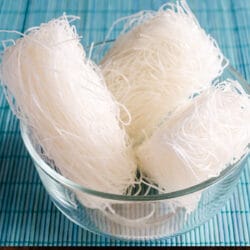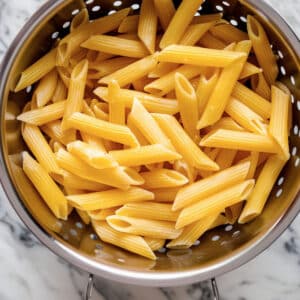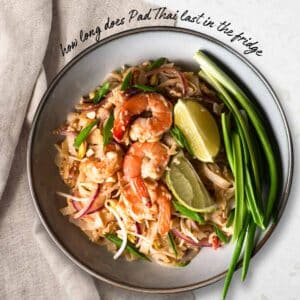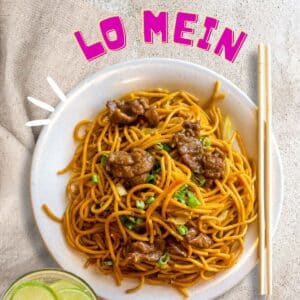If you love rice noodles as much as I do, you'll be pleased to hear that you can make them in advance. It is easier as well to make a large batch, some for now and some for later.
Storing them is quick as they remain nice and fresh - something I will explain fully in a moment.
Asians love their rice noodles. They use them in a wide range of dishes, including in things like ramen, salads, and of course, stir-fries.
Once you've read through this article on how to keep them lovely and fresh for use later, they will probably feature as a regular part of your weekly menus.
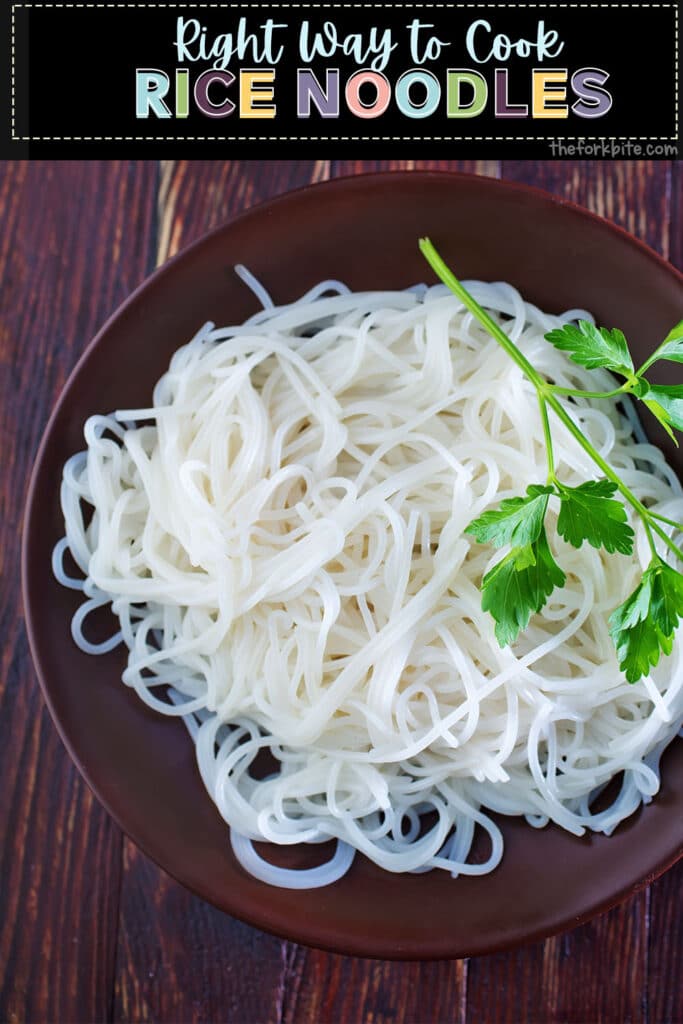
Are rice noodles really made from rice?
Yes, rice noodles (a fundamental ingredient of many Asian dishes) are made from rice. All it takes to make them is some rice flour and a little water.
Get the proportions and preparation spot on, and your noodles will have a delightful slight chewiness with a great, springy texture.
They are a tad lighter than wheat flour noodles, something that appeals to me greatly.
You can include them as an ingredient in salads, with a delicious peanut lime dressing drizzled over. It gives any salad a lovely salty umami-ness, with a hint of citrus and vinegar.
Rice noodles are a must-have ingredient in soups and stir-fry dishes like Drunken Noodles or Pad See Ew.
Related article: Pad Thai vs Pad See Ew
The right way to cook rice noodles
There is a right way in cooking anything, and if you follow the instructions below, you will end up with perfect rice noodles every time.
If you are using dried noodles, you don't need to boil them. You simply soak them in hot water to hydrate them.
You can then add them to any stir-fry, and if the skillet or wok is nice and hot, they will cook in seconds.
The trickiest part with dried rice noodles is soaking them for the right amount of time. Read on, and all will be revealed in due course.
The various types of rice noodles
In Asia, where rice noodles are a popular ingredient in many dishes, you can buy both fresh or dried ones.
Here in the US, the type you see most commonly is the dried variety. You can find them in the refrigerated section of many Asian grocery stores.
Various countries have their own type of rice noodles, and they alter in terms of size and shape. They are usually labeled as "rice noodles" or sometimes as "rice stick" noodles in the US.
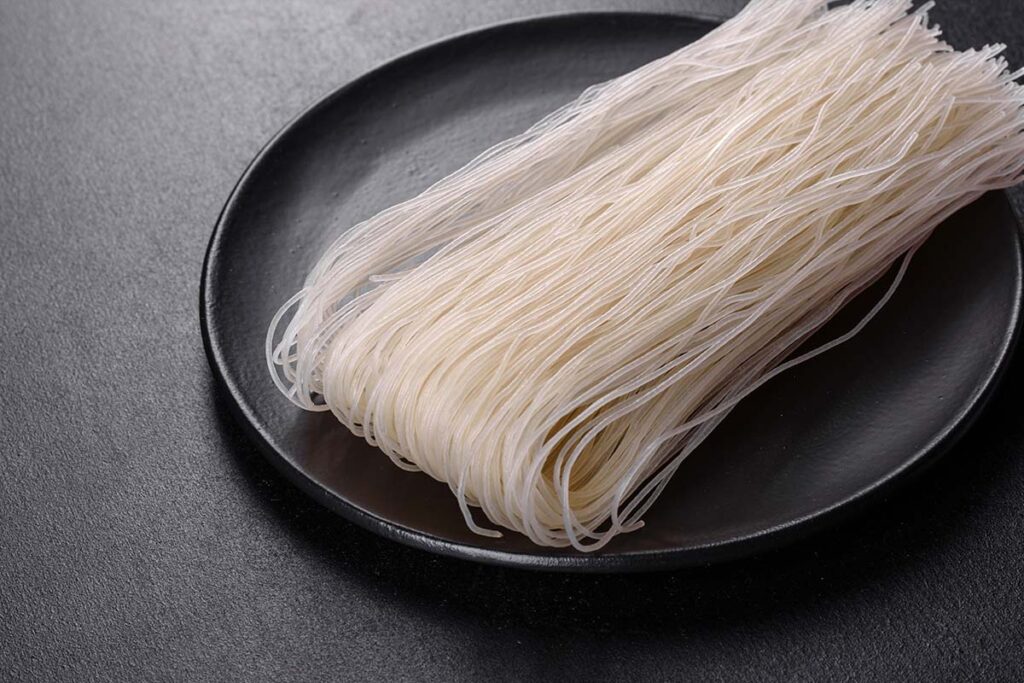
The main difference is usually how wide the noodles are. The packaging doesn't typically denote this, but thankfully, the packaging usually is transparent, so you can see for yourself just how wide they are.
The "Taste of Thai" brand of rice noodles is available in four different widths.
The four most common types of rice noodles you'll come across are:
1 Very thin
These are quite similar to angel hair pasta; in fact, they are often labeled as "angel hair" or sometimes "vermicelli."
2 Thin rice noodles
These are approximately ⅛" wide. You can find it with a round profile similar to spaghetti or a flat shape rather like linguine. You will see these noodles labeled as "Pad Thai" rice noodles.
3 Medium rice noodles
Medium rice noodles are also sometimes labeled as "Pad Thai" or "Stir-fry" noodles. These are usually about ¼" wide and are very similar to linguine.
Some brands may be a little wider looking, rather like fettuccine. One of my favorite ways of using them is when making rice noodles with vegetables.
4 Wide rice noodles
Wide rice noodles are wider again - something like pappardelle pasta. I sometimes use these when making the Pad See Ew dish I mentioned earlier.
More about rice noodles
Rice noodles, sometimes called "Fun" in Cantonese as in Beef Chow Fun, have a subtle rice flavor. They are not used for their taste as much as for bulking out a meal and giving it more substance and a comforting sense of texture.
You do need to be aware that they cook very quickly. Fresh need noodles only require 1 or 2 minutes to cook, while their dried cousins only require rehydrating in hot water before adding as an ingredient.
That means that when you add them, make sure everything else in the dish you're cooking is ready; otherwise, if they're left sitting too long, they will clump together.
1 Vermicelli rice noodles
Vermicelli rice noodles are white, very thin, and delicate in texture. You can add them to a wide variety of dishes, including soups, stir-fries, and spring rolls.
Other names for these delicate noodles include mi fén, bun, sen mae, mai fun, and bee hoon. They are a great addition to many vegan dishes.
You can buy them in packets, in dried bunches that are bent in half. They are very thin, round in profile, and, depending on the brand, can be up to 18 inches in length.
Texture-wise, when hydrated, they are soft and slippery and have a slight chewiness.
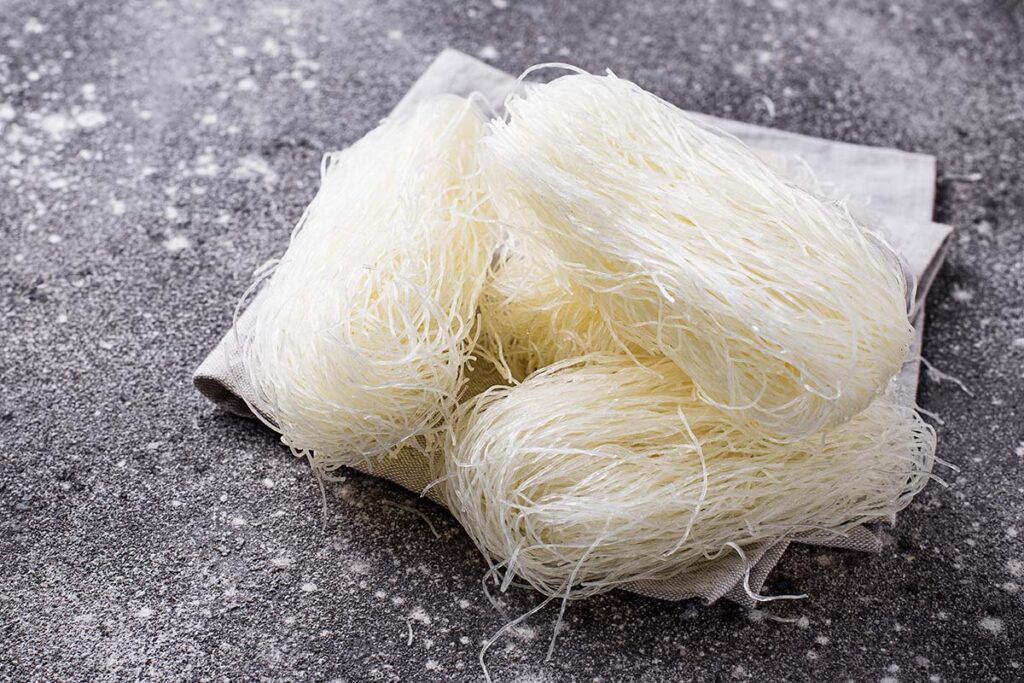
Texture:
Soft, slippery, and slightly chewy when cooked; they are often:
- Added to soups
- Chilled and added to salads
- Used to make spring rolls
- Added to stir-fries
- Deep-fried until crispy, then used as nests for saucy dishes
They are an excellent accompaniment for seafood. A good example is a Singaporean dish, Crab Bee Hoon.
Other recipes in which they are used include:
2 Kway Teow
Kway Teow rice noodles are similar to fettuccini but thicker and wider.
Being more substantial, they carry sauce better, creating velvety noodle dishes, which you often see in Singapore on street food stalls.
They also go by other names, including Gou Tiao and Sen Yai.
Whether you buy them fresh or dry, they are approximately ¼ "wide, long, and flat. Some brands you can buy are round and thin, rather like linguini.
In terms of texture, they are slippery and lightly chewy, as all good noodles should be.
Because they carry sauce so well, they are fantastic with hearty sauces with strong flavors, like Char Kway Teow.
They are also wonderful in stir-fries and soups such as Spicy, Coconut Laksa.
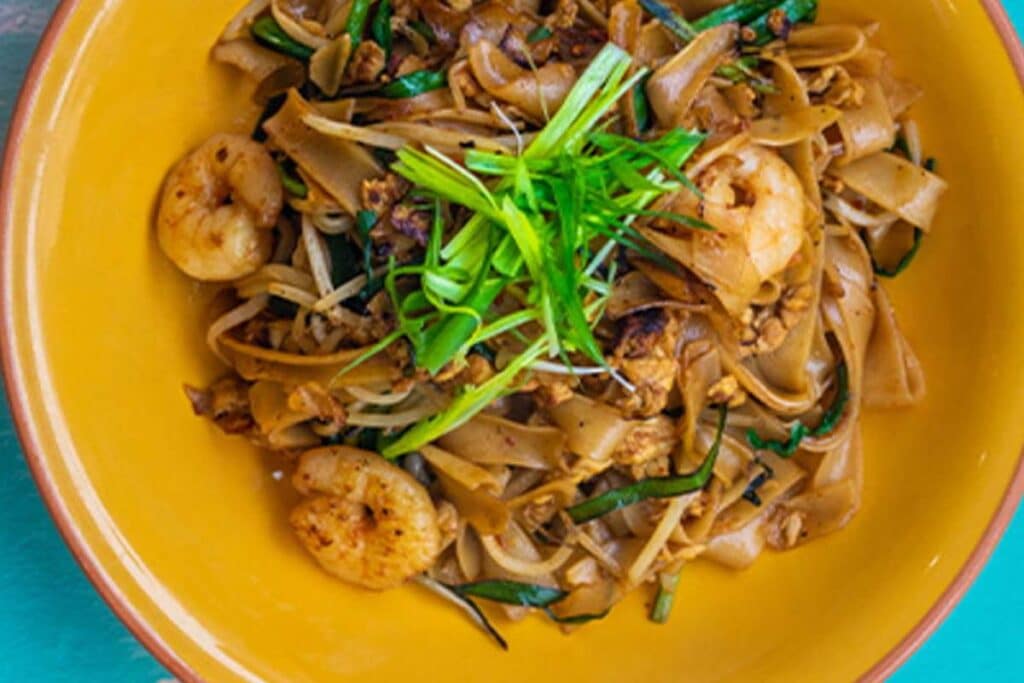
3 Rice Sticks
Rice sticks are an alternative name for a type of rice noodle. They are another of the hundreds of different kinds of noodles popular across the Asian continent.
Rice sticks come in three different sizes, and each has its own name:
- Thin rice noodles thin - vermicelli
- Medium rice noodles - Banh Pho (Vietnamese)
- Wide rice noodles - Jantaboon (Thai Pad Thai noodles)
All rice sticks produce a noodle that is slippery in the mouth with a slightly firm chewiness.
Rice sticks are mostly used in Southeast Asia and are an ingredient in soups, pho - (a type of soup), Pad thai, and stir-fries, of course.
Some specific recipes include Beef Pho and Chicken Pad Thai.
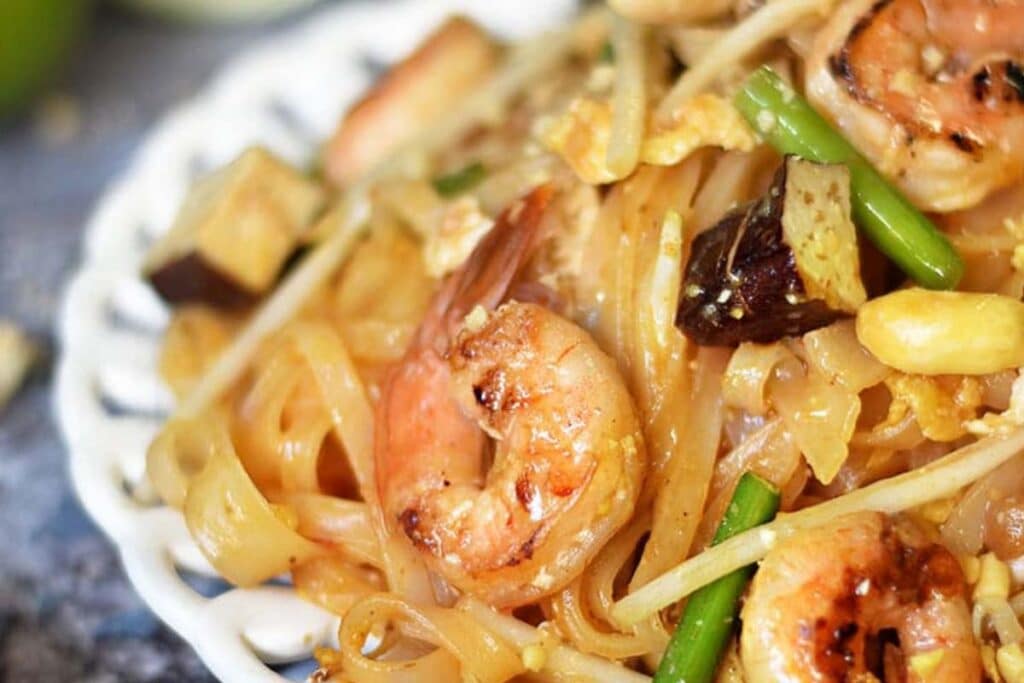
4 Chow Fun and Mi Xian rice noodles
I did warn you there are lots of different types of noodles.
Here are some more.
Chow fun rice noodles are wide (up to two inches wide), flat, and have a soft, full-bodied chew. The Cantonese use them by the ton.
MiXian rice noodles can be round or slightly flat and have an even fuller-bodied, soft chew. They are medium-thin and are usually cut into 12" lengths.
They are velvety in texture, slippery and chewy, but they will begin to fall apart if left in hot broth or water for a long time.
Ideally, you can cook and eat them as soon as they are made.
Chow fun rice noodles are great with rich sauces, while MiXian rice noodles work brilliantly in soups and stir-fries. If the noodles are not as fresh as you would like, it's best to boil or steam them.
Less-than-fresh noodles can be steamed or briefly boiled, but they're best when you consume them the soonest after cooking.
Chow fun is great when stir-fried with rich sauces like soy thickened with cornstarch. Mixian is used in stir-fries and spicy soups.
Some super recipes for these noodles include Chow Mei Fun | Singapore Noodles and Beef Chow Fun.
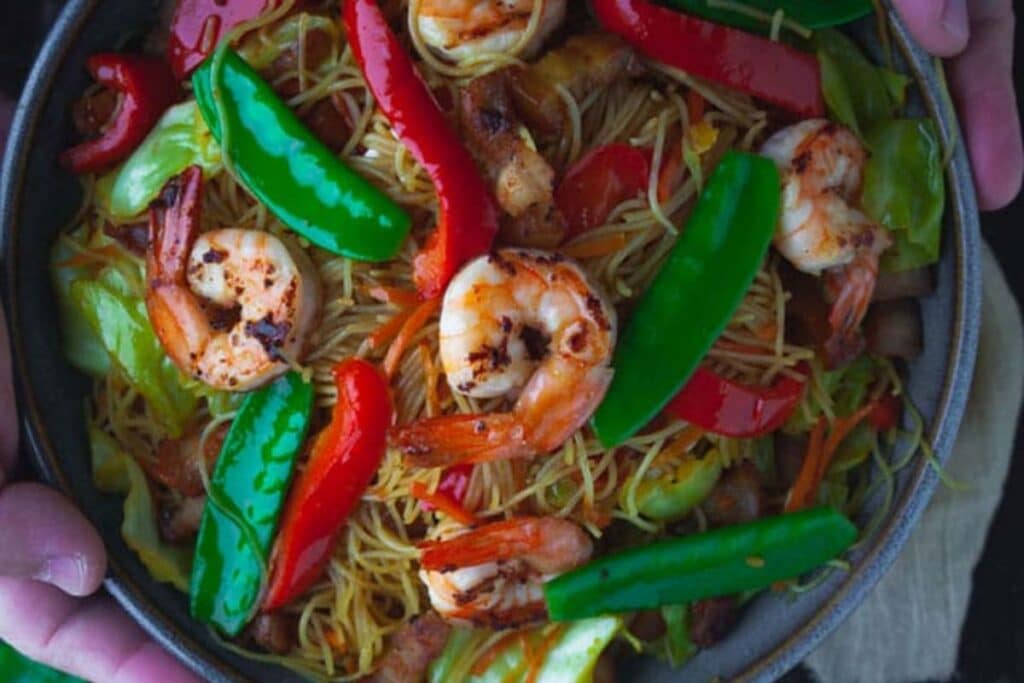
5 Chee Cheong Fun rice noodles
These are a wider version of Chow Fun noodles, but they get wound up to resemble a sort of cannelloni.
Chee Cheong Fun rice noodles have a lovely, velvety smoothness with a soft, chewy bite to them, and once you've tried them, you'll be hooked for life.
If you're really lucky, you might come across some freshly made on the weekend in an Asian deli near you.
It would be best if you eat them fresh, and when you do, you'll understand why.
They are gorgeous.
If you do track them down, they usually are around six to eight inches long. You can either eat them as they are, or unroll them, stuff them and roll them back up again.
They are also known as Chee Cheong Fen, Pig Intestine Noodles, Steamed Rice Rolls, or Zhaliang noodles.
Popular stuffings include beef, pork, or shrimp smothered in soy sauce. In different parts of Asia, they are sometimes sold as a Zhaliang, a snack wrapped around You Tiao (deep-fried doughnut sticks).
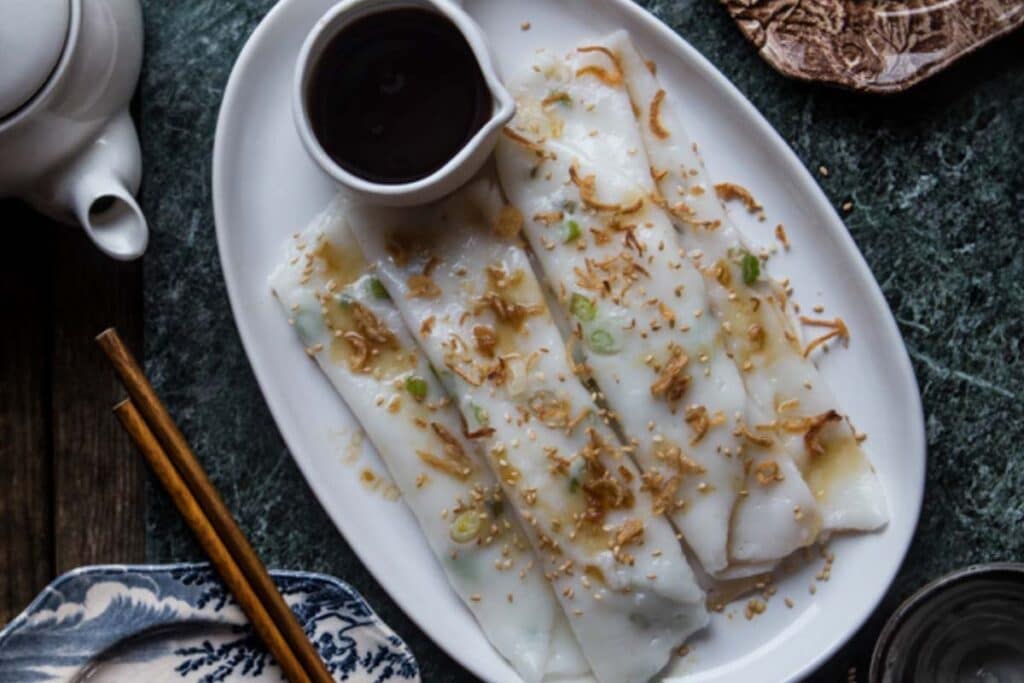
6 Silver Needle rice noodles
Silver Needle rice noodles have several other names, including Lao Shu Fen, Pearl, Pin, Rat Tail, and short rice noodles.
They are made from a mixture of rice flour, gluten-free wheat, and tapioca starch.
The more rice flour in the mix, the whiter, more opaque, and less chewy the noodle. The tapioca starch gives the noodles a slippery, glossy, good, firm chew and a comforting texture.
Shape-wise, Silver Needle noodles are round (about ¼" wide) and stubby (only approximately 2" in length) and have pointy tips, making them look a little like small white worms.
Texture-wise they are slippery little suckers with a velvety but firm texture.
They are used in casseroles, soups, and stir fry dishes.
They use these noodles in typical dishes like Lo Shun Fu, Silver Noodle Soup.
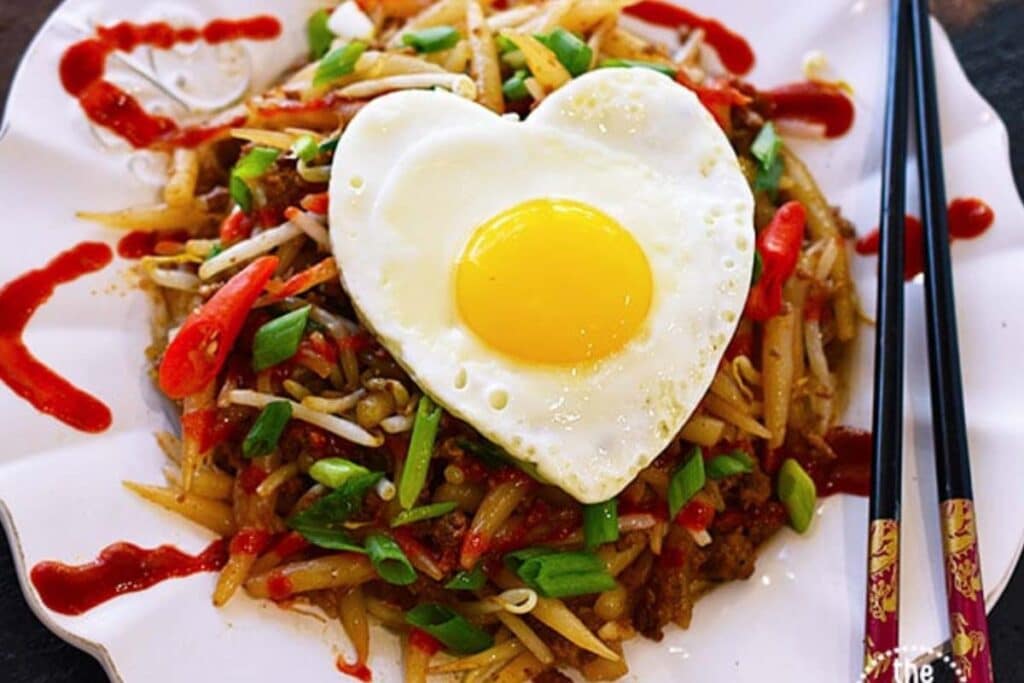
What is the difference between rice noodles and regular noodles?
Rice grains are the most common form of rice in Asia. It is, after all, their food staple. Next comes rice noodles.
Pasta is more prevalent in the US, but millions of Americans like rice too.
Ordinary pasta contains more nutrients than rice, but the good news is that rice is gluten-free.
Even the stuff referred to as "glutinous rice" doesn't contain any. The same too are rice noodles made with just rice flour and water.
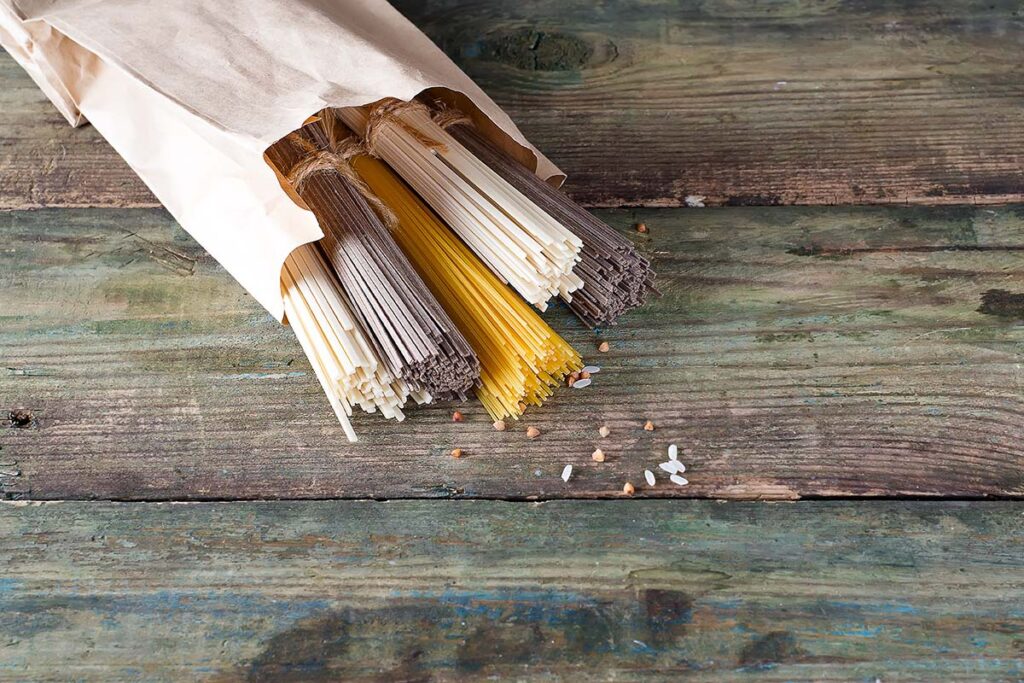
Let's study the nutritional differences a little closer.
1 Comparing vitamins
Pasta contains more vitamins than rice by adding folic acid, niacin, riboflavin, and thiamin.
Folic acid, which is converted in your body to folate, is good for pregnant women as it aids healthy fetal growth. Pasta has nearly 30 times the amount of folate than rice noodles.
2 Comparing minerals
Pasta also wins out in terms of minerals. It contains significantly more calcium, iron, magnesium, phosphorous, potassium, and zinc.
3 Comparing protein
Pasta is also the winner when comparing protein. It contains 4.06 per cup as opposed to rice noodles which comprise only 0.8 grams.
4 Comparing carbs and fiber
Rice noodles have a slightly higher carb content than rice noodles - 21.91 as opposed to 21.6 grams, and as far as fiber goes, the difference is more marked - rice noodles have only 0.9 grams against pasta's 1.3 grams.
5 Comparing calories and fat
These are battles that rice noodles do win, though not by much. They contain 96 calories and 0.15 grams, compared to pasta with 111 calories and 0.65 grams.
In conclusion, on the nutrient front, pasta is healthier overall, but rice noodles are the way to go if you count calories.
Instructions on how to cook rice noodles
The best way of cooking dried rice noodles is pretty much a case of personal choice. If you start serving them up regularly, you will soon decide which method suits you best.
But it's worth pointing out to rice noodle newbies that some brands tend to soften quicker than others.
You need to try a few different brands to decide which ones you prefer.
In terms of prepping dried rice noodles, you have four options.
Option 1 - The quick hot water soak
Step 1
With this option, boil a pan of hot water, remove it from the heat and pour it straight over the noodles.
Step 2
Give them a quick stir to help them separate, cover, and leave to soak for between six and ten minutes.
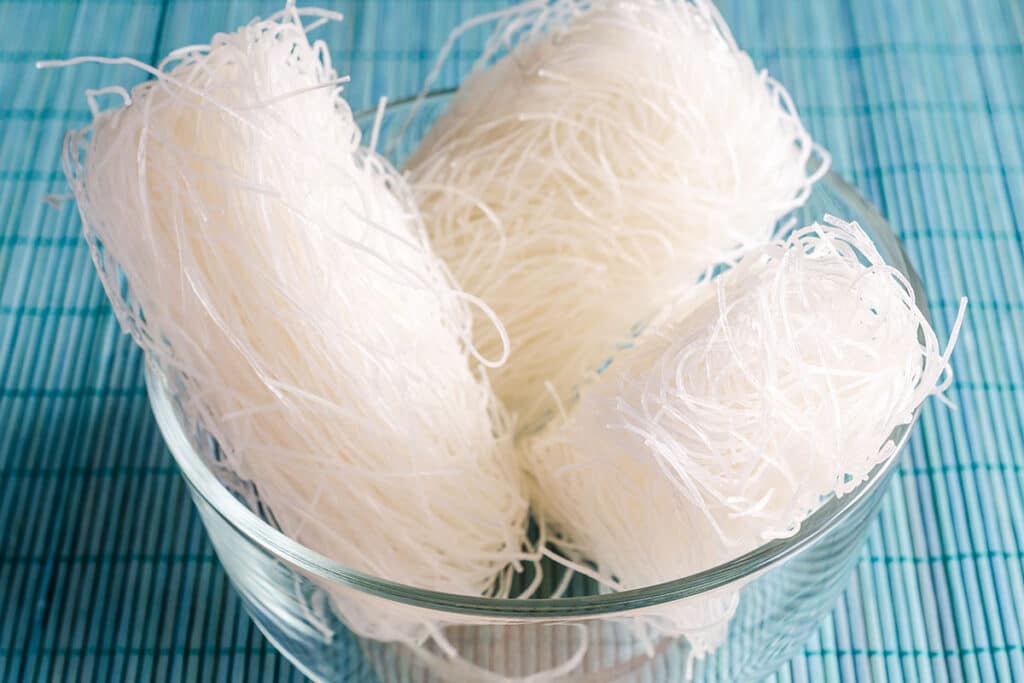
Step 3
Drain the hot water and rinse the rice noodles under the cold water tap. They are ready to use.
Step 4
Experiment with the soak time to get the chewiness you prefer.
Option 2 - The slow hot water soak
With this second option, use hot tap water and allow them to soak for about about 30 minutes.
Although the cooking time is much slower, this method reduces the chances of oversoaking and ending up with too soft noodles.
Option 3 - The long coldwater soak
Soaking rice noodles in cold water requires a significantly longer soak - several hours.
This method is even better at ensuring the noodles don't get over-soaked if you have the time.
Option 4 - The quick boil method
This is the fastest method of all - it only takes a one-minute boil (depending on the amount you put), after which you rinse the noodles immediately in cold water to stop the cooking process.
However, you need to take precautions for the cooking duration because you can easily overcook the noodles and end up with a stodgy, gooey mess.
How to soak dried rice noodles
Pre-soaked rice noodles are essentially ready to eat as soon as you finish the soaking process. A lot of people use them cold in salads and when making spring rolls.
If you add pre-soaked noodles to a recipe you are making, they only require about two or three minutes in a hot wok to warm through.
Don't add too many at once; I find about 6 ounces to be optimum.
If you need to add a lot of rice noodles, do so a little of the time and stir after each addition to mix in with the other ingredients.
When using a thicker rice noodle, the long hot water soak option may be the best solution.
How to tell rice noodles have soaked long enough.
There is only one way to tell whether or not your rice noodles have had adequate soaking, and that is the bite test.
When you bite through a noodle, its texture is hard and firm. Which means you should soak the noodles long enough.
The texture you're looking for is soft and comfortingly chewy.
If you are adding noodles to a stir-fry recipe, they will soften a little as they cook. For this reason, I usually soak dried noodles I will be stir-frying, so they are a little on the firm side of soft.
What happens to over-soaked noodles?
When rice noodles get over-soaked, they become somewhat soft and mushy. They also tend to clump together and have a gluey, sticky texture.
There is also a danger of them falling apart when you stir-fry them, leaving little rice noodle "niblets" in your dish rather than the nice long noodles for which you hoped.
Storing fresh rice noodles in the fridge
There's no doubt in my mind that the best way to enjoy rice noodles is to eat them when they've just been made.
However, suppose you make them in advance or have some leftovers and want to keep or store them for future use.
- In that case, it's best to soak them to get rid of any possible contamination and transfer them into a shallow airtight container.
- Fit the lid tightly in place and store it in your fridge for up to 3 to 4 days.
- You can also store rice noodles in your refrigerator in a Ziploc bag, providing you evacuate as much air as possible before sealing.
- Before refrigerating fresh noodles, it's important to get rid of any excess moisture. If you don't, it will turn to condensation in the fridge, making the noodles soggy.
- As with most fresh foodstuffs, they shouldn't be left outside at room temperature for longer than two hours.
- It's always a good idea to check them after day three. If, however, you don't think they've stored well, throw them away.
- In case they've become a little hard, you can soften them by soaking them in hot water for a few seconds, after which you should cover them with a sheet of paper kitchen towel for 30 seconds.
How long do rice noodles last?
It is advisable not to leave rice noodles for more than two hours outside the fridge for safety reasons.
Storing fresh rice noodles in the fridge can extend its life span from 3 to 4 days.
Hence, you can make them last for at least two months without sacrificing the quality and texture once you store them in the freezer.
However, dry rice noodles can be in their original package and can last for 12 months.
From my experience, they could last for more than a year, but if you store them for an extended time, their quality will start to deteriorate.
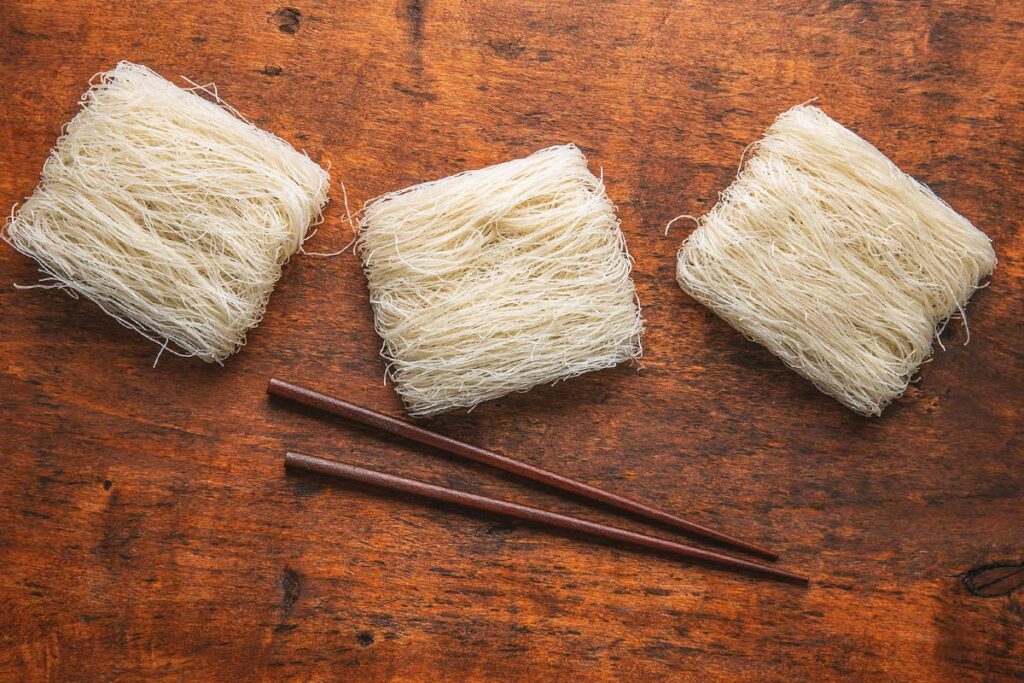
How to keep fresh rice noodles from sticking together
One problem with storing fresh rice noodles in the fridge is that they tend to clump together. You can prevent this by covering them lightly in oil.
Before you do so, rinse the noodles under the cold water tap until the water runs reasonably clear.
Pat the noodles dry with a paper kitchen towel and lightly toss in a bit of oil, ensuring that you coat the noodles evenly.
Pack as described above and transfer into your fridge.
Freezing fresh rice noodles
You can successfully freeze fresh rice noodles for up to 2 months.
Before freezing, wash the noodles under cold water to eliminate any contamination and excess starch, then pat dry with a paper kitchen towel.
Transfer the noodles into a freezer-safe Ziploc bag or airtight container and position them flat in your freezer.
How to reheat frozen rice noodles
Before reheating frozen fresh rice noodles, you should defrost them. You can do this by immersing them in hot water and leaving them for 10 minutes.
When the 10 minutes is up, drain off the water and rinse the noodles under the cold water tap before immersing them in warm water and allowing them to sit for a further five to ten minutes, after which they will be ready to use.
Reheating leftover rice noodles in the microwave
The microwave is a fast and convenient way of reheating many foods, including rice noodles.
Here's how:
- Transfer the leftover rice noodles into a microwave-safe bowl
- Cover the bowl with cling them
- Microwave at full power for 30 seconds per serving
- Carefully remove the bowl from the microwave, making sure not to burn yourself; remove the cling film and serve.
Related questions
It's not absolutely necessary. However, I always do because a cold water soak removes any remaining starch, which means they will be less likely to stick together.
The other thing is that a cold water rinse immediately stops the noodles from softening any further. This is particularly important if using the quick boil or long hot soak method.
Once rice noodles have been soaked and rinsed, if you're adding them to a recipe in a hot wok or non-stick skillet, they only need a minute or two's cooking.
It warms them up nicely and allows them to soak up some of the sauce they are cooking.
It's important not to add too many rice noodles into a wok at the same time. I aim for a maximum of 6 ounces of noodles.
If I need more, I add them a little at a time. That way, all the noodles get a better chance of being distributed evenly throughout the dish and warming through nicely.
Yes, rice noodles made with just rice flour and water are completely gluten-free.
How to Cook Rice Noodles
Pin RecipeEquipments:
- Bowl
- thong
Ingredients:
- 8 oz dried rice noodles
Instructions:
Option 1: The quick hot water soak
- With this option, boil a pan of hot water, remove it from the heat and pour it straight over the noodles.
- Give them a quick stir to help them separate, cover, and leave to soak for between six to ten minutes.
- Drain the hot water and rinse the rice noodles under the cold water tap. They are ready to use.
- Experiment with the soak time to get the chewiness you prefer.
Option 2: The slow hot water soak
- With this second option, use hot tap water and allow them to soak for about about 30 minutes.
- Although the cooking time is much slower, this method reduces the chances of oversoaking and ending up with too soft noodles.
Option 3: The long coldwater soak
- Soaking rice noodles in cold water requires a significantly longer soak – several hours. This method is even better at ensuring the noodles don’t get over-soaked if you have the time.
Option 4: The quick boil method
- This is the fastest method of all – it only takes a one-minute boil (depending on the amount you put), after which you rinse the noodles immediately in cold water to stop the cooking process.
- However, you need to take precautions for the cooking duration because you can easily overcook the noodles and end up with a stodgy, gooey mess.
Please note that all nutrition information are just estimates. Values will vary among brands, so we encourage you to calculate these on your own for most accurate results.

